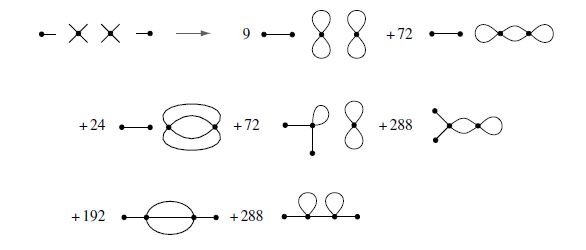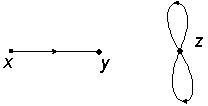User:DimitriosLazarou: Difference between revisions
No edit summary |
No edit summary |
||
| Line 50: | Line 50: | ||
We want to compute <math> \left \langle \phi(x)\phi^4(z')\phi(y) \right \rangle </math>. Let's just write the final result, no arrows this time to make it easier. The numbers in front of the diagrams are called combinatorial factors and they are obviously positive integers; they represent the total ways that this particular topology can be realized: | We want to compute <math> \left \langle \phi(x)\phi^4(z')\phi(y) \right \rangle </math>. Let's just write the final result, no arrows this time to make it easier. The numbers in front of the diagrams are called combinatorial factors and they are obviously positive integers; they represent the total ways that this particular topology can be realized: | ||
[[File:4v-2nd_order. | [[File:4v-2nd_order.JPG]] | ||
The problem of determining the combinatorics remains highly non-trivial. For example in the next correction, (3rd), the number of terms are (14-1)!!=135135. We will address it later. | The problem of determining the combinatorics remains highly non-trivial. For example in the next correction, (3rd), the number of terms are (14-1)!!=135135. We will address it later. | ||
We will highlight some general remarks of Feynman diagrams and then we will attempt to calculate a more interesting case of interacting fermions. | We will highlight some general remarks of Feynman diagrams and then we will attempt to calculate a more interesting case of interacting fermions. | ||
Revision as of 18:12, 5 December 2011
Feynman diagrams
Complete calculations of Green's functions is a rather formidable task. Even the basic imaginary time evolution operator itself is an infinite series to all orders in the interaction . One can simply get lost in the dozens of integrals; his physical intuition also doesn't get things any better. Feynman diagrams are both an exact mathematical representation of perturbation theory in infinite order and a powerful pictorial method showing in a unique way the physical content of a given expression.
The introduction of Feynman diagrams to Solid State Physics came naturally in order to give an alternate, and more easy to use, way to apply perturbative concepts beyond lowest orders. Given the so-called Feynman rules, a process can be illustrated in a much more transparent way. This alternate formulation is completely equivalent with the algebraic one. The correspondence with Quantum Field Theory, (QED, QCD and more) where the diagrams were first introduced, is more than obvious. Julian Schwinger once said rather bitterly that "Feynman brought quantum field theory to the masses". This will become apparent at the end.
Simple examples
The quantity of interest is a Green's function. The language used more often in QFT is the propagator. More precisely we are interested in the n-th order corrections of it. Of course even from the 2nd order things become slightly complicated as we will see. Let's begin with no interaction at all, just the calculation of the probability of the propagation of a particle from position x to position y, or in a more accurate language the quantity which as we know is represented by a Green's function, i.e. . In the language of Feynman diagrams it means that we draw an internal line at x and an external line at y.
The internal line is represented by a leg (line) having an arrow that moves to a vertex (a solid dot) ![]() and the external line by a leg moving from a vertex
and the external line by a leg moving from a vertex ![]() .
.
In order to construct the simplest diagram of all, we connect the two vertices in the only possible way, a line:
and by simplifying things we keep only the in between part
which is nothing else but .
1st order correction Let's try now a more complicated vertex, we will demonstrate the 1st order correction to Green's function. Let's suppose that we have 2 fields again , one in position x and another in y. . Hence we have 2 lines as before. But now the vertex we put in between (position z) is this one, we call it vertex :
Now we should connect the two lines, external and internal, with the above vertex in all possible ways. One way is just to connect x with y and ignore the vertex. Of course we take into account the vertex lines and we draw the appropriate (directional in this case) loops between them:
(If there are no arrows, our loops also have no arrows, we will show it next, in 2nd order correction).
Now the other possibility is to connect x with z and z with y. In our case it can be done in 2 ways as far as the internal line is concerned because there are 2 ingoing lines in the vertex, and in other 2 ways for the external lines, total of 4 ways. The lines from the vertex that remain unconnected, form a loop as before. Let's illustrate this, (having in mind that the topology of the following two diagrams is the same though and that in the future they will be represented as one diagram):
Therefore the three above diagrams represent the total average which now can be analyzed in 2 terms that contain the Green's functions, first term for the first unconnected diagram and the 2nd term for the other two connected diagrams:
The simplification in terms of Feynman diagrams is obvious. This is the 1st order correction to the Green function.
2nd order correction
The 2nd order correction contains 2 vertices at z, z' positions, with no arrows now:
We want to compute . Let's just write the final result, no arrows this time to make it easier. The numbers in front of the diagrams are called combinatorial factors and they are obviously positive integers; they represent the total ways that this particular topology can be realized:

The problem of determining the combinatorics remains highly non-trivial. For example in the next correction, (3rd), the number of terms are (14-1)!!=135135. We will address it later.
We will highlight some general remarks of Feynman diagrams and then we will attempt to calculate a more interesting case of interacting fermions.











